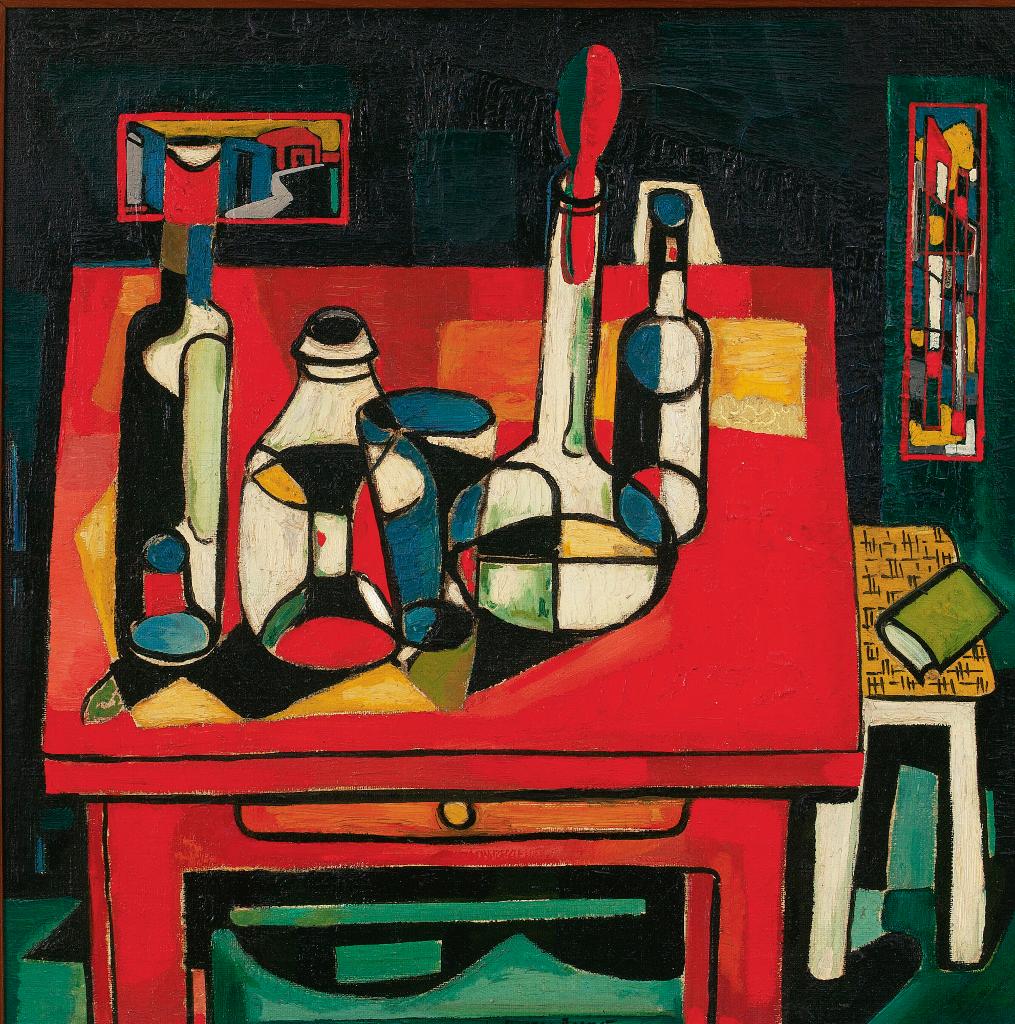
Interior
45.6 cms x 45.6 cms (18 ins x 18 ins)
Signed lower centre. Signed and inscribed "Montreal" on the reverse and titled on the stretcher
Lot offered for sale by Sothebys, Toronto at the auction event "Important Canadian Art" held on Thu, May 24, 2012.
Lot 86
Lot 86
Estimate: CAD $15,000 - $25,000
Realised: CAD $71,500
Realised: CAD $71,500
Lot description - from the online catalogue*
Provenance:
Private Collection, Greenwich, CT
Literature:
Helen Duffy and Frances K. Smith, "The Brave New World of Fritz Brandtner", Kingston, 1982, pp. 25, 38, 44, 49 - 50, cat. no. 26, for a closely related work entitled "Bottle Still Life" reproduced in colour.
Notes:
Born in Danzig, Germany in 1896, Brandtner dreamt of becoming an architect. At 18, he was sent to the Russian front, and spent the next six years as soldier, captive, and imprisoned labourer. Too poor to afford art school, Brandtner set about a rigorous program of self-education through books on the European artists of his time, such as Emile Nolde, Max Beckmann, Lyonel Feininger and George Grosz.
As the increasingly-powerful Nazi party tightened its grip over German culture, persecuting the very artists whose bold new forms of expression inspired him, Brandtner foresaw no future in his homeland, and in 1928, he set sail for Halifax and eventually settled in Winnipeg. Back in Europe, works by the "Blaue Reiter" and "Brücke" artists were being labeled degenerate, and were destroyed; across the ocean, Brandtner felt even more compelled to work in their Expressionist vein.
Though he found a community for himself among Canada's artists, Brandtner also found the country's lack of exposure to contemporary European movements shocking, even after relocating to Montreal in 1934. Despite his abundant output, his art was little understood, as Duffy and Smith wrote, "in a society indoctrinated by traditional Dutch and British landscapes and the Group of Seven."
While perhaps too avant-garde for the Canadian art world of his time, Brandtner's work has since been re-evaluated. In "Interior", Brandtner masterfully uses curvilinear lines evocative of Fernand Léger to fuse underlying and overlying planes into one design. Rendered in brightly saturated hues, this canvas reveals the artist's extraordinary handling of colour and balance; the primary tones can be seen as a nod to Piet Mondrian, while the tilted table, seen in several of Picasso and Braque's best interior works, attest to the influence of Cubism.
Private Collection, Greenwich, CT
Literature:
Helen Duffy and Frances K. Smith, "The Brave New World of Fritz Brandtner", Kingston, 1982, pp. 25, 38, 44, 49 - 50, cat. no. 26, for a closely related work entitled "Bottle Still Life" reproduced in colour.
Notes:
Born in Danzig, Germany in 1896, Brandtner dreamt of becoming an architect. At 18, he was sent to the Russian front, and spent the next six years as soldier, captive, and imprisoned labourer. Too poor to afford art school, Brandtner set about a rigorous program of self-education through books on the European artists of his time, such as Emile Nolde, Max Beckmann, Lyonel Feininger and George Grosz.
As the increasingly-powerful Nazi party tightened its grip over German culture, persecuting the very artists whose bold new forms of expression inspired him, Brandtner foresaw no future in his homeland, and in 1928, he set sail for Halifax and eventually settled in Winnipeg. Back in Europe, works by the "Blaue Reiter" and "Brücke" artists were being labeled degenerate, and were destroyed; across the ocean, Brandtner felt even more compelled to work in their Expressionist vein.
Though he found a community for himself among Canada's artists, Brandtner also found the country's lack of exposure to contemporary European movements shocking, even after relocating to Montreal in 1934. Despite his abundant output, his art was little understood, as Duffy and Smith wrote, "in a society indoctrinated by traditional Dutch and British landscapes and the Group of Seven."
While perhaps too avant-garde for the Canadian art world of his time, Brandtner's work has since been re-evaluated. In "Interior", Brandtner masterfully uses curvilinear lines evocative of Fernand Léger to fuse underlying and overlying planes into one design. Rendered in brightly saturated hues, this canvas reveals the artist's extraordinary handling of colour and balance; the primary tones can be seen as a nod to Piet Mondrian, while the tilted table, seen in several of Picasso and Braque's best interior works, attest to the influence of Cubism.
Most realised prices include the Buyer's Premium of 18-25%, but not the HST/GST Tax.
(*) Text and/or Image might be subject matter of Copyright. Check with Sothebys auction house for permission to use.
(*) Text and/or Image might be subject matter of Copyright. Check with Sothebys auction house for permission to use.